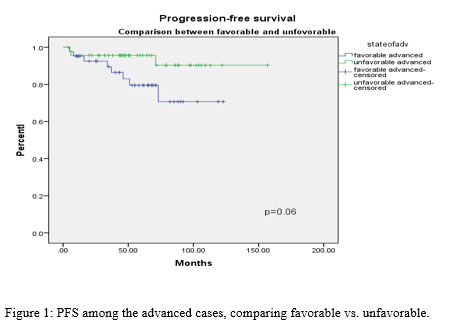
Contributions
Abstract: PB1557
Type: Publication Only
Session title: Hodgkin lymphoma - Clinical
Background
Background: Hodgkin’s lymphoma (HL) is a common malignancy among a young population with a reported improved outcome. There has been major changes in the mamagement stratgies of HL over the past two decades; less chemotherapy and smaller RT filed and dosing. In the current study, we report the long-term outcome in a population-based cancer center after adotping the changes in management in our HL cases.
Aims
The aim of the study is to monitor the long-term outcomes of treatment strategies adopted from international studies thar were implemented in a community-based cancer senetr
Methods
Data from consecutive sets of patients diagnosed with HL between 2000-2016 were collected by ERIC and subjected to detailed statistical analysis. Collected variables included: demographics, stage at diagnosis, treatment, treatment response, and death. Early favorable-early stage HL cases were generally treated with abbreviated ABVD courses (2 cycles) followed by involved-field radiotherapy (IFRT). Unfavorable-early stage HL cases were treated with four courses of ABVD and IFRT (20 Gry). 6 courses treated advanced stage HL cases of ABVD.
Results
186 cases are included in this analysis. The majority were males, representing 57.5% of the cases. The majority are adolescents and young adults, between 20-40 years, with a median age of 31. The most common histology is Nodular sclerosis, representing 59% of all diagnosed cases. The median progression-free survival (PFS) among the entire group is 159 (CI:144-175) months. The median survival among the early stages HL is 160(CI:8-144) months compared to 150 (12_125) months in the unfavorable early stages( P value=0.5). The advanced favorable HL PFS is 99 (CI:85-114), compared to 150 (12-125) months among the unfavorable group (p=0.06)

Conclusion
We report the long-term survival among the local HL cohort from Kuwait. The cohort achieved long-term survival compared to the historical data. There is no difference between the favorable and the unfavorable early stages HL cases. The outcome represents a non-inferiority in the early favorable patients treated with short courses of ABVD and limited RT. There is no difference in survival among advanced stages HL; favorable vs. unfavorable. However, there a trend of lower survival among the favorable group. This finding warrants longer follow-up.
Key-words: Hodgkins lymphoma' outcome, lon-term
Keyword(s):
Abstract: PB1557
Type: Publication Only
Session title: Hodgkin lymphoma - Clinical
Background
Background: Hodgkin’s lymphoma (HL) is a common malignancy among a young population with a reported improved outcome. There has been major changes in the mamagement stratgies of HL over the past two decades; less chemotherapy and smaller RT filed and dosing. In the current study, we report the long-term outcome in a population-based cancer center after adotping the changes in management in our HL cases.
Aims
The aim of the study is to monitor the long-term outcomes of treatment strategies adopted from international studies thar were implemented in a community-based cancer senetr
Methods
Data from consecutive sets of patients diagnosed with HL between 2000-2016 were collected by ERIC and subjected to detailed statistical analysis. Collected variables included: demographics, stage at diagnosis, treatment, treatment response, and death. Early favorable-early stage HL cases were generally treated with abbreviated ABVD courses (2 cycles) followed by involved-field radiotherapy (IFRT). Unfavorable-early stage HL cases were treated with four courses of ABVD and IFRT (20 Gry). 6 courses treated advanced stage HL cases of ABVD.
Results
186 cases are included in this analysis. The majority were males, representing 57.5% of the cases. The majority are adolescents and young adults, between 20-40 years, with a median age of 31. The most common histology is Nodular sclerosis, representing 59% of all diagnosed cases. The median progression-free survival (PFS) among the entire group is 159 (CI:144-175) months. The median survival among the early stages HL is 160(CI:8-144) months compared to 150 (12_125) months in the unfavorable early stages( P value=0.5). The advanced favorable HL PFS is 99 (CI:85-114), compared to 150 (12-125) months among the unfavorable group (p=0.06)

Conclusion
We report the long-term survival among the local HL cohort from Kuwait. The cohort achieved long-term survival compared to the historical data. There is no difference between the favorable and the unfavorable early stages HL cases. The outcome represents a non-inferiority in the early favorable patients treated with short courses of ABVD and limited RT. There is no difference in survival among advanced stages HL; favorable vs. unfavorable. However, there a trend of lower survival among the favorable group. This finding warrants longer follow-up.
Key-words: Hodgkins lymphoma' outcome, lon-term
Keyword(s):


